HARRISON — The Harrison Food Bank wasn’t scheduled to open for hours, but it was already busy inside.
Dozens of volunteers, many in red shirts or aprons with the food bank logo, chatted with one another but never took their focus off the task at hand: getting ready to feed more than a thousand Mainers.
The first volunteers had arrived as dawn broke, and the last would leave well after dark. Over the course of 12 hours on Tuesday, they sorted and packaged thousands of pounds of food, delivered groceries to 425 homes, and distributed food boxes to more than 600 people who drove through the parking lot.
This is what it takes to feed people in a region of Maine where food insecurity rates are high, incomes are low and residents are increasingly relying on the emergency food system for help.
Like many food assistance programs across the state, the Harrison Food Bank has seen a surge in demand as Mainers grapple with rising costs, the largest cuts in history to the Supplemental Nutrition Assistance Program and uncertainty about monthly benefits during the government shutdown.
Many who come to the food bank on Tuesdays are from Oxford County, where more than 15% of residents — and nearly 1 in 4 children — are experiencing food insecurity. More than 18% of households rely on SNAP to buy groceries.
“You look at the million-dollar mansion on the lakes and you think this is a wealthy community,” said Sandy Swett, who runs the food bank. “It’s not.”
RESCUING FOOD
Just after 8 a.m. on Monday, Swett’s husband, Terry, and their dog Smudge rolled up behind the Windham Walmart in a box truck. He backed the truck into the loading dock area and hopped out, clipboard in hand and a pen tucked behind his ear.
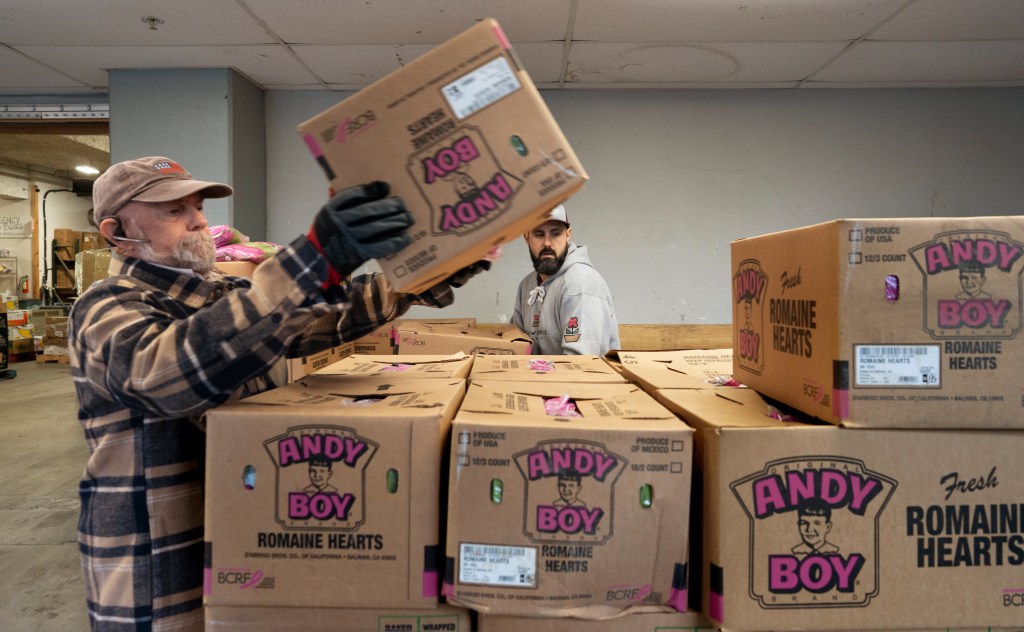
At least five days a week, two trucks from the food bank spend hours on the road. Volunteers drive through several counties to pick up food from Hannaford, Shaw’s, Sam’s Club, Costco, Walmart, Whole Foods and Wayside Food Programs.
Much of it would go to waste otherwise.
“This is free food that would normally go to a landfill,” Sandy Swett said. “There’s still plenty of goodness left in this food.”
Terry Swett greeted Walmart employees by name as he headed inside to find a pallet stacked with a couple dozen banana boxes. He made quick work of writing down the contents — frozen meat and vegetables, bags of fruit, boxes of shelf-stable food — and used a pallet jack to maneuver it into the back of the empty truck.
“It’s as simple as that,” he said as he jumped back in his truck, with two Hannaford stores and Wayside in Portland next on his list of stops.
By the end of the morning, the truck was loaded with the donations needed to make sure people arriving at the food bank the next day would get full boxes.
BUILDING A FOOD BANK
Sandy Swett’s first phone call on Tuesday came at 6 a.m., long before she finished her farm chores at home and headed to the food bank. Some days, she gets dozens of calls and emails from people with questions: Is the food bank open? Can I come for food?
Sometimes, those calls come in after hours from people with no food at home and no way to buy more. Swett always gives them an emergency box.
Swett, 71, never imagined she’d spend nearly all of her time fighting food insecurity. Back in 2016, a deacon at a local church suggested she start a food pantry. The following spring, she rented a corner in the basement of an old concrete building owned by the local Veterans of Foreign Wars chapter for $100 a month and started getting food to 16 families.

Eventually, as the food bank grew, the VFW donated the entire building to the nonprofit.
Swett, who previously worked as a development director writing strategic plans for cities, applied for grants and raised money to transform the old concrete building into a modern-day food bank, fully equipped with walk-in coolers and large rooms with tables and shelves for sorting and storing.
The food bank is now consistently distributing 40,000 pounds of food a week to more than 1,000 households. People come to the pantry from 63 communities, some more than an hour’s drive away.
AN EARLY START
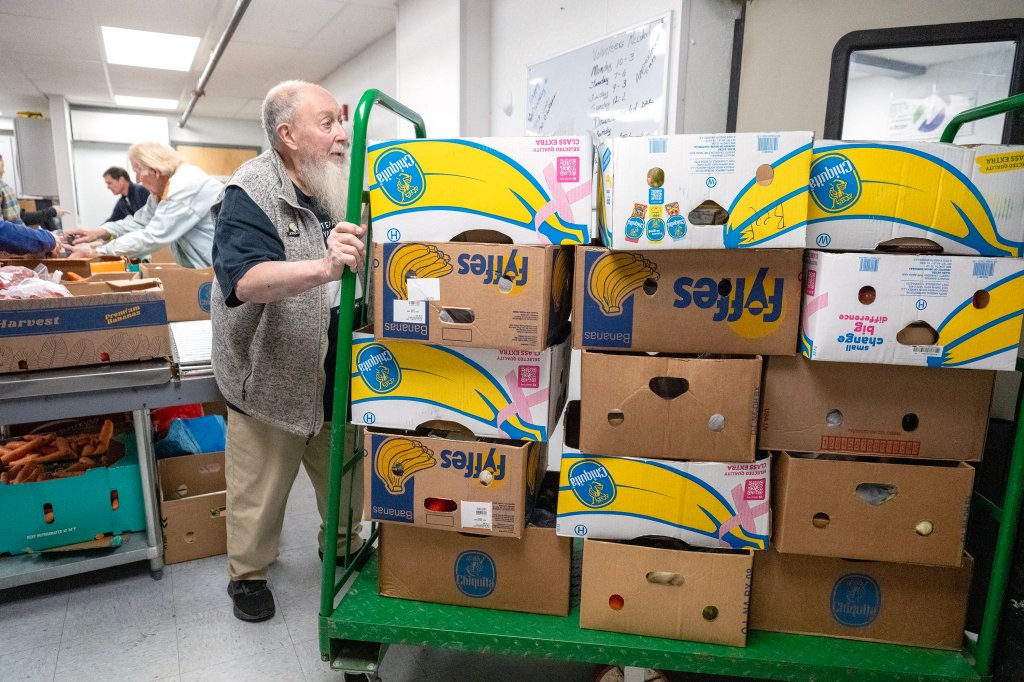
Kristin Humphrey was one of the first volunteers to arrive at the food bank on Tuesday, but her day started at home at 4:30 a.m. planning out delivery routes and making sure everything was in place to distribute monthly senior food boxes.
She worked at a table in a large room where a dozen volunteers pulled meat from the freezer and bagged produce into household size servings. This early group of volunteers were packing hundreds of boxes that would be delivered by other volunteers over the next few hours.
It’s a delicate balance: They want to make sure the boxes are full, but more food deliveries will arrive throughout the day, and the food bank never knows ahead of time how many people will show up.
Susan Shaw, of Bridgton, a volunteer for the past six years, spent part of the morning sorting a shopping cart full of avocados to put into individual boxes.
“It’s busy, busy, busy today,” she said amid a flurry of activity as volunteers moved carts laden with boxes to be loaded into cars for delivery.
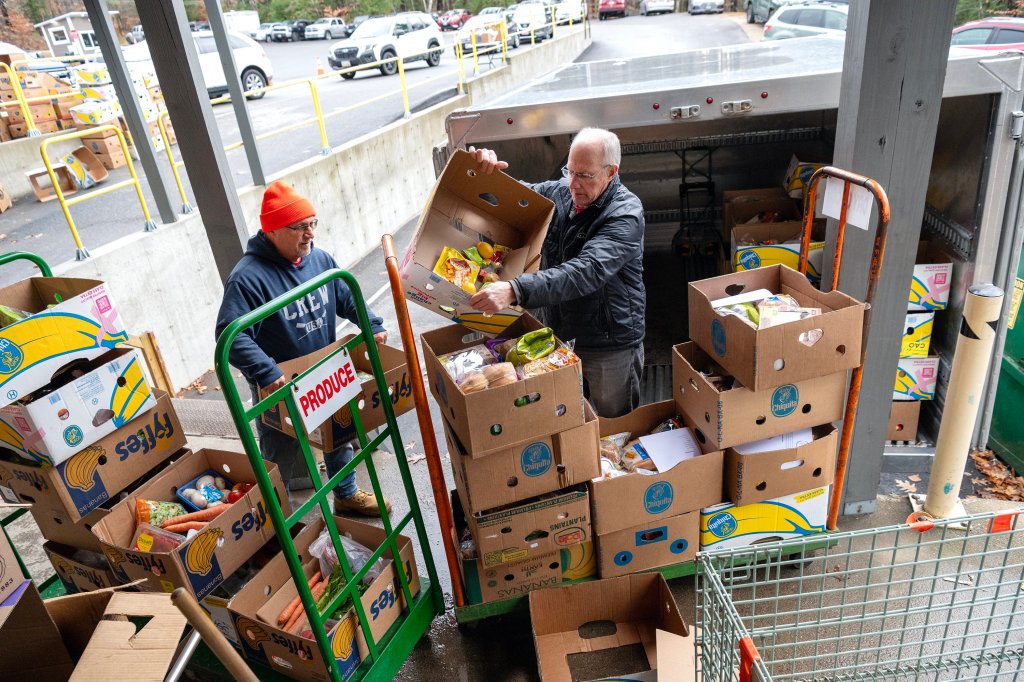
Before Tuesday, the shelves in the Harrison Food Bank’s dry goods room were nearly empty of canned vegetables, pasta and cereal. But two churches held huge food drives over the weekend and delivered enough canned goods to restock the shelves in time.
“This is neighbors helping neighbors,” Swett said.
COMMUNITY CONNECTIONS

Retired educators Steve McFarland and Robert Dow arrived at the food bank before 9 a.m. to pack a truck for a delivery route that will take most of the day and connect them with some of the food bank’s most vulnerable clients.
“It’s tough times,” McFarland said. “I don’t know how people would be getting by otherwise.”
Swett said the relationships McFarland, Dow and other delivery drivers make with recipients goes far beyond dropping a box at the door. Dow checks on a one woman in Waterford to make sure her generator is running after snowstorms, and he always takes deliveries inside for another woman who uses a wheelchair.
“She really is so appreciative when we walk in the door and put food on her table,” Dow said. “She’s almost in tears every time.”
At 9:30 a.m., Del Arey pulled his pickup truck into line in front of the food bank. The 85-year-old volunteer from Harrison shows up every week to take food to eight stops.
His truck packed, Arey headed toward Bridgton and Fryeburg. As he pulled into the first driveway, he beeped his horn several times and an older man came to the door. They talked for a minute as Arey unloaded boxes, then he hopped back in his truck.
One of Arey’s favorite stops is the Fryeburg home of Vietnam veteran Merle Wentworth, 76, who always comes out to talk to his favorite food bank volunteer. When Arey found out Wentworth had a leaky roof, volunteers came to cover it with tarps until it could be repaired.
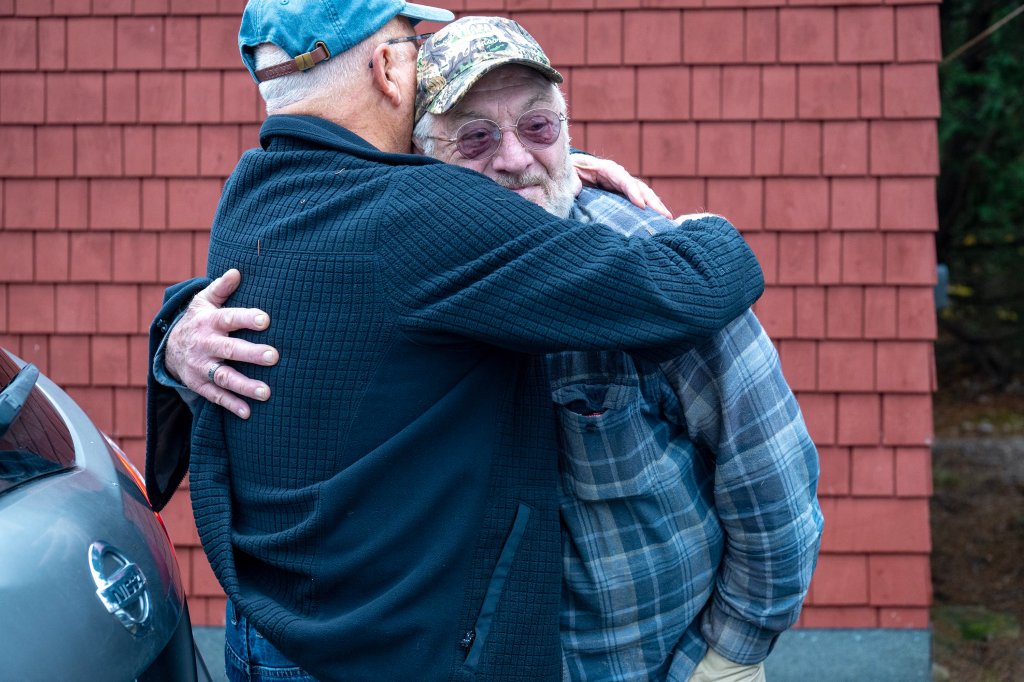
“I couldn’t ask for better,” Wentworth said. “They’re such a help to me.”
After Arey carried food boxes into the house, Wentworth pulled him into a hug.
“I love you, boy,” Wentworth said.
Arey’s next stop was the Snow School Apartments in Fryeburg, home to about 30 people. Most of them need some help with food, but the individual household boxes were too much for some. So resident Ethelyn Walker reached out to Swett and arranged for deliveries that would help her stock a small food pantry in the building’s community room.
“If we didn’t have this, some of us wouldn’t be eating,” Cynthia Davis, 65, said as residents unpacked their delivery. “You have to decide if you want medication or food.”
‘YOU DON’T GO HUNGRY’
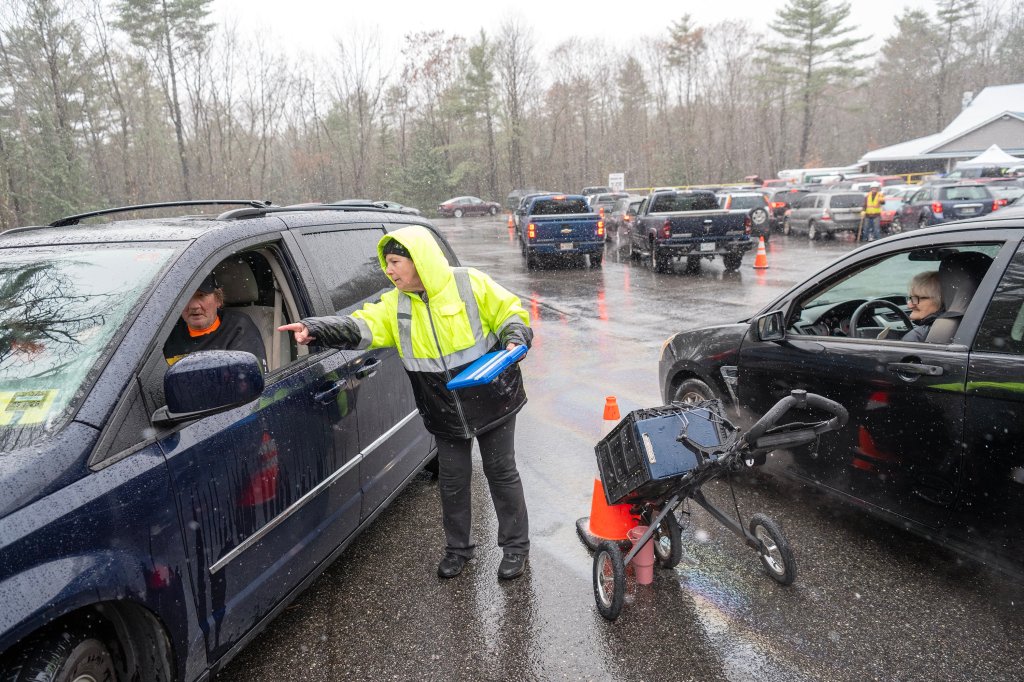
People start to arrive at the food bank hours before distribution officially starts at noon. Some come to check out a tent of free donated items. Others show up early just to make sure they can get food. Later in the afternoon, when many food bank clients get out of work, the line will stretch out onto the road.
Vanja Cochran, of Norway, picked up food for the first time Tuesday. She had volunteered the day before, which made her feel comfortable enough to come back as a client. She said it’s become harder for her and her husband to afford groceries for their family of four.
“It’s a lot with the price of everything going up,” she said. “We can’t stay on top of it.”
The food bank has been a lifeline for Alan and Brenda Mann, of Stow, whose only income is their Social Security. Without it, they’d have to go without a lot of things, she said.
“If you come here, you don’t go hungry,” Alan Mann said.

While volunteers in brightly colored safety vests directed vehicles through the parking lot, Swett greeted people in their cars. She knows, or at least recognizes, most of them. After checking in with a woman who was picking up diapers for her granddaughter, Swett’s phone rang again.
The snow that had started a few hours earlier was falling harder now. The person on the other end wanted to know if the food bank was open and if they could pick up food. The answer is always yes.
“They can come from the moon for all I care,” Swett said after ending the call. “I’m going to feed them.”
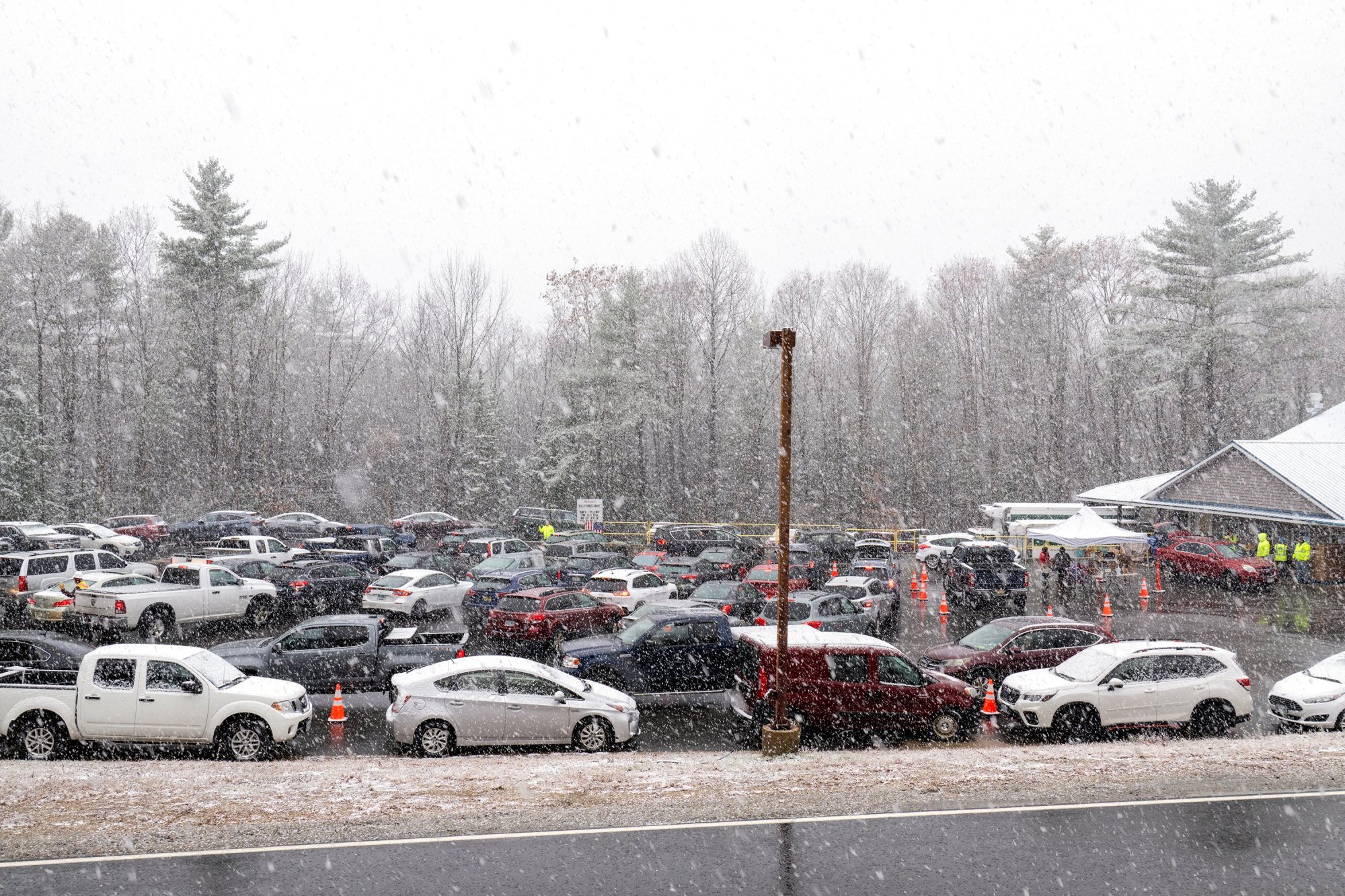

We invite you to add your comments. We encourage a thoughtful exchange of ideas and information on this website. By joining the conversation, you are agreeing to our commenting policy and terms of use. More information is found on our FAQs. You can modify your screen name here.
Comments are managed by our staff during regular business hours Monday through Friday as well as limited hours on Saturday and Sunday. Comments held for moderation outside of those hours may take longer to approve.
Join the Conversation
Please sign into your CentralMaine.com account to participate in conversations below. If you do not have an account, you can register or subscribe. Questions? Please see our FAQs.